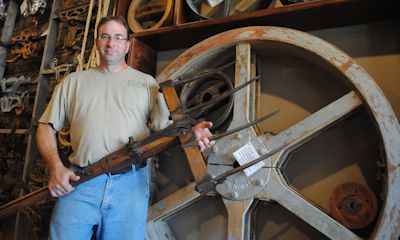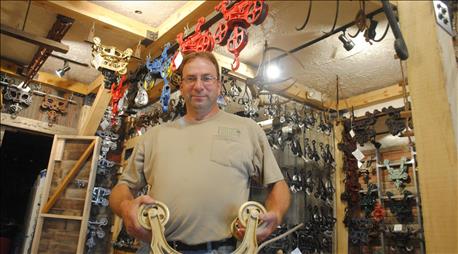
Doug de Shazer operates his own contracting business, but over the past 10 years he has amassed one of the largest collections of farm pulleys and hay tools in the country. He and his wife, Juliet own the Lewis and Clark Pulley Museum on Main Street in Crofton, exhibiting hundreds of rare pulleys and antique hay tools.

ANTIQUE HAY TOOLS: The Lewis and Clark Pulley Museum has several rare items, including this 1858 horse-drawn hay fork held by de Shazer. "The fun for me is in finding different items in old barns that I don't have and searching for the rare ones," de Shazer says.
Visitors to the museum are astounded when they walk into the main display hall, because de Shazer has designed the building to look exactly like the inside of a turn-of-the-century barn, with hay carriers and pulleys displayed neatly by manufacturers along the walls and hanging from the ceiling. He says that of the few serious hay tool collections in the U.S., his museum is the only known collection open to the public.
De Shazer became interested in pulleys in 2005 because they were such an important tool to haul the hay crop into the loft of a barn for winter storage in the old days. "I was at a flea market and found a few farm pulleys," de Shazer recalls. "I was just fascinated with them and how they looked and worked."
From that modest beginning, he began to research farm pulleys used in hay handling and hay carriers commonly used in the late 1800s and into the early 1900s, until the advent of tractors and elevators. The heyday for hay carrier manufacturers was probably between 1880 and 1910, when the majority of the patents were filed. De Shazer has about 300 hay carriers made by 60 manufacturers, but he says there were hundreds of patents granted. He restores the carriers by researching them meticulously replacing missing parts and repainting them in original colors and detailing.

BARN SETTING: Hay carriers and tools are literally hanging from the barn rafters at the Lewis and Clark Pulley Museum in Crofton. "I was just fascinated with them, and how they looked and worked," de Shazer says.
Many of the carriers in his collection are rare, with only one or two known specimens left. He has a Louden hay carrier that was the first one patented, made in Fairfield, Iowa. But, de Shazer also owns one of the last carriers made in the early 1940s, which he says are actually just as rare because so few were made and sold.
In addition to carriers, he also has hay forks that date back to before the Civil War, including an 1858 horse-drawn hay fork. De Shazer's collection not only includes hay carriers, forks and other hay tools, but toys and other products made by some of the most prominent hay equipment manufacturers of the day.
"The fun for me is in finding different items in old barns that I don't have and searching for the rare ones," de Shazer says. "I love the research and learning the history of how these worked, how much time and work they saved farmers and the history of their manufacturers. When the hay carriers came out, it was such a work saving device for farmers, compared to moving all of their hay with a pitchfork."
Currently, the museum is open to visitors by appointment. You can learn more by calling de Shazer at 402-510-8845.
About the Author(s)
You May Also Like






